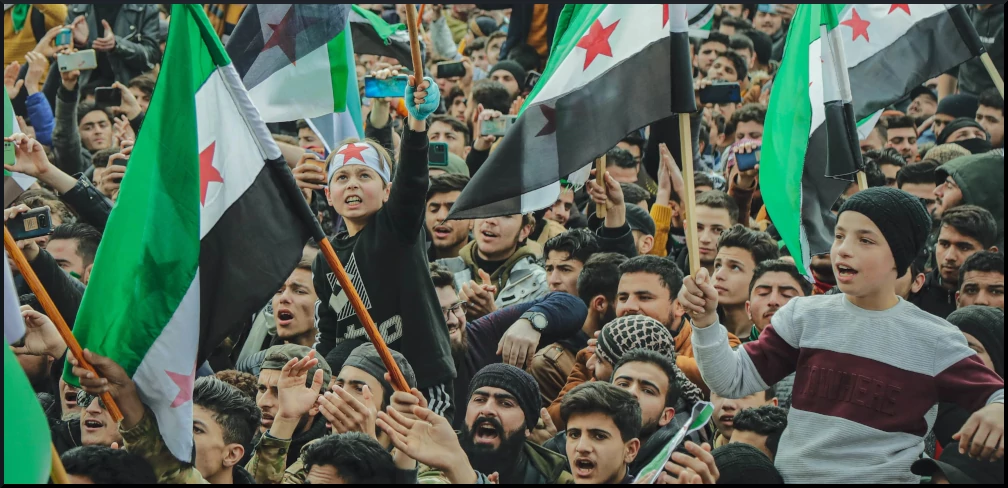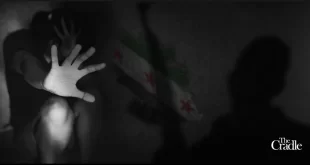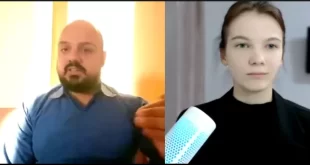by William Van Wangenen, published on the Libertarian Institute Website, August 3, 2022
In the mainstream view, the armed groups fighting the Syrian government since 2011, collectively known as the Free Syrian Army (FSA), were part of a Syrian revolution that represented the Syrian people. At the same time, the Syrian government, or Assad regime, allegedly represented only a small number of loyalists, in particular from President Assad’s minority Alawite community. Such a view undergirded demands by Western and Gulf-funded think tank scholars, who claimed that the Syrian people wished for FSA groups to be armed, and even for Western military intervention on behalf of the FSA, whose fighters they sympathetically described as rebels.
For example, Shadi Hamid of the Brookings Institution claimed in February 2012 that
“…we find ourselves in an odd but increasingly common situation, where Syrians themselves are more enthusiastic about foreign military intervention than Americans are. It is, in this sense, the reverse of Iraq, which was rightly seen by many as a tragic Western imposition.”
However, there is no evidence that the FSA ever enjoyed significant popular support among Syrians, including among Syria’s Sunni community, the FSA’s presumed demographic base. Instead, Syrians broadly feared the FSA groups, which invaded town after town and city after city over the course of the war.
Syrians widely hated and feared the so-called rebels because, contrary to the mainstream narrative, the armed groups comprising the FSA were not secular and democratic, nor comprised primarily of army defectors. As I have shown elsewhere, the early earliest and strongest FSA factions were primarily comprised of civilians-turned-fighters from Syria’s Salafist community, which in turn served as auxiliaries for foreign jihadist groups, namely the al-Qaeda offshoots of the Nusra Front, Ahrar al-Sham, and ISIS.
Once the Salafist orientation of the early FSA groups is acknowledged, this helps explain why Syria’s armed opposition groups enjoyed such little popular support from the civilians they claimed to want to liberate from Assad’s rule. The Salafist orientation of the major FSA groups, with its religious intolerance and sectarian motivated hatred of religious minorities, was simply at odds with Syrian culture broadly, including Syrian Muslim religious culture, which was largely Sufi in orientation. Only through massive military and financial support from the U.S., Britain, France, Saudi Arabia, Qatar, and Turkey, was the FSA, along with the Nusra Front and Ahrar al-Sham, able to pose a serious threat to the Syrian army and government.
In the remainder of this essay, I discuss the evidence showing that most Syrians rejected the FSA, and in turn either wished to remain neutral in the conflict or supported the Syrian government in combating the foreign-sponsored Salafist insurgency that plunged Syria into chaos starting in 2011.
The Spread of Black Flags
The first reason Syrians broadly rejected the FSA is an intuitive one, namely that Syrians living in a stable, religiously tolerant society simply feared the sectarian Salafist armed groups invading their towns and cities. Acknowledging this, opposition supporter and prominent al-Jazeera contributor Azmi Bishara wrote in 2013 that, “Islamic jihadist groups were part of the Free Army” and that their “presence aroused significant fear among Syrians,” due to the “spread of black Islamic flags making reference to al-Qaeda, and the appearance of religious sharia courts.”
That Syrians broadly feared the FSA is also not surprising given the brutal tactics used by these groups. Writing for al-Quds al-Arabi, journalist Wael Essam notes that, “Many believe that what distinguishes ISIS is the role of foreign jihadists and the practices of its extremist elements in beheading, for example,” however, “the moderate Islamic factions and the Free Army carry out many similar practices…but the difference is advertising.”
While most Syrians are religious, the majority are of course not sectarian religious extremists. They therefore did not want the FSA invading their towns and cities and raising the black flag of al-Qaeda, as quickly happened after a coalition of so-called rebel groups, including FSA brigades, Ahrar al-Sham, and the Nusra Front captured Raqqa, the first provincial capital to come fully under opposition control during the war, in March 2013.
“It Has Always Been That Way”
The case of Aleppo, Syria’s second largest city, clearly indicates that the FSA did not enjoy broad popular support. The FSA and Nusra Front invaded Aleppo in July 2012. The beginning of the campaign to capture the city was announced by prominent FSA leader Abdel Qadar al-Saleh in a video alongside a Nusra commander.
After the invasion, an FSA commander acknowledged to The Guardian that, “Yes it’s true…Around 70% of Aleppo city is with the regime. It has always been that way. The countryside is with us and the city is with them.” Journalist Rania Abouzeid, who reported from on the ground in Syria for years, wrote that what she called the revolution, “had devolved into anarchy,” and that “Perhaps nowhere was the chaos more evident than in the great northern metropolis of Aleppo,” which was “dragged into the uprising in July 2012 like a hostage” by men who “weren’t welcomed by locals—men with little camaraderie, undisciplined groups, some of which looted the homes of civilians they claimed to be protecting.”
Additionally, if the FSA groups invading Aleppo had enjoyed broad popular support, their fighters would have largely come from the most populated cities in Syria. Instead, most came from the less populated countryside. For example, Abouzeid noted in December 2012 that,
“At the same time as announcing plans for an Islamic state in Aleppo, Jabhat al-Nusra has begun undertaking relief efforts in the neighborhoods of the city it is based in, seeking a stronger foothold in the local community, even though paradoxically like many rebel groups operating in Aleppo, its fighters are largely not from the city.”
Given the poverty prevalent in the Syrian countryside, many young men joined FSA groups for financial as much as ideological reasons. Funding from Salafist networks and intelligence agencies in the Gulf created the demand for the formation of armed groups to fight the government, whose demand was filled by entrepreneurs-cum-warlords. This led to many FSA groups in Aleppo becoming notorious for their criminal activities, which damaged the already limited popularity of these groups still further. Syrian journalist Edward Dark noted for example that in Aleppo,
“Some rebel groups are no more than organized crime syndicates, opportunistically engaging in kidnapping, extortion and large-scale looting of factories and warehouses. The fact that the ‘good guys’ in the rebels haven’t been able to stop them casts a very dark shadow on all the rebels here.”
Additionally, many insurgents invading Aleppo were not from Syria at all. One Nusra commander in Aleppo told The Washington Post in July 2012 that his men were fighting as part of the FSA’s Liwa al-Tawhid, and that “his contingent included men from Morocco, Libya, Tunisia and Lebanon, as well as one Syrian who had fought in Iraq against the Americans.” In August 2012, correspondents from The Guardian also observed seeing anti-government fighters from other parts of the Islamic world, including Saudi Arabia, Pakistan, Algeria and Senegal.
The heavy al-Qaeda presence within the Syrian opposition groups was acknowledged by CIA case officer Douglas Laux, who operated undercover in Syria and observed that as of February 2013, the Syrian opposition was “chock full of al-Qaeda under the banner ISI,” referring to the Islamic State of Iraq, which founded Nusra and which shortly thereafter became ISIS.
Author Nu’man Abd al-Wahid observes that despite the obvious jihadist presence within the FSA, Western-based opposition activist Robin Yassin-Kassab nevertheless bizarrely sought to portray the Salafist invasion and looting of Aleppo as a socialist revolution led by freedom fighters struggling on behalf of Syria’s working class. That FSA fighters were looting Aleppo’s factories, selling the equipment to capitalists in Turkey, and thereby destroying Syria’s industrial base, rather than seizing factories to be owned and managed by Syrian workers, appeared not to concern Yassin-Kassab. Nor was he concerned when FSA groups and Nusra looted Syria’s state-owned oil resources in April 2013, and sought to sign contracts with Western oil firms to export Syria’s oil for their own, rather than the Syrian people’s benefit.
An Alawite Regime?
It is often claimed that the Alawite-dominated Syrian government is waging a war against Syria’s Sunnis, and that therefore the country’s Sunnis universally support the FSA’s fight against the government. Aleppo, however, is a majority Sunni city, and most of its residents nevertheless sided with the government and the Syrian army. This should not be surprising, given that, as Roland Popp of the Center for Security Studies at ETH Zurich observes;
“Asad is by no means the head of a ‘minority regime,’ as is often argued. The religious group of the Alawites (which accounts for about 12 per cent of the population), to which Asad’s family belongs, is certainly over-represented in the country’s leadership and particularly in the officer corps. But this is mainly due to a system of rule which is based on patronage and clientelism. The large majority of Alawites has hardly benefited from Asad’s rule at all. Indeed, important parts of the Sunni-Arab majority, who make up about two-thirds of the population, have been integrated into the Asad system and constitute an important part of the economic elites in the country’s major cities. Asad will strive to keep at least parts of these groups on his side, although this is becoming increasingly difficult as the fighting spreads to the country’s economic centres and the sectarian antagonism becomes increasingly aggravated.”
Falsely casting the conflict as between Alawites on the one hand, and all of Syria’s Sunnis on the other, was a deliberate strategy employed by the opposition in the hope of encouraging Sunni Syrian soldiers to defect from the army. Popp notes further that, “Some rebels believe that by recasting the conflict as a sectarian antagonism between the Sunni majority and pro-regime minorities—which include not only Alawites, but also Christians, Ismailis, and Druze—they can accelerate the disintegration of the armed forces.” Stoking a sectarian civil was therefore to the advantage of the opposition, not the Syrian government, as is often claimed. It is also consistent with a Salafist worldview, with its sectarianism dating back to the thought of the medieval theological innovator, Ibn Taymiyyah.
Such an outcome, a Sunni-Alawite civil war and the collapse of the Syrian state and army, was viewed positively by elements of the Israeli intelligence community, because such a scenario would “obstruct Iran from its nuclear activities for a good deal of time,” and possibly “even prove to be a factor in the eventual fall of the current government of Iran.” The desire to weaken Iran explains in part why not only Israeli, but also U.S. planners supported the Syrian opposition, of which al-Qaeda constituted “a big chunk,” as acknowledged by Barack Obama’s deputy national security advisor, Ben Rhodes.
“They Know What They Don’t Want”
Fear of the Salafist-dominated FSA groups meant that many Syrians critical of the government and hopeful of reforms therefore had no choice but to support the government and look to the Syrian army for protection once the prospect of heavily armed Salafist armed groups invading their cities, towns, and villages became clear.
For example, Robert F. Worth of The New York Times quoted one Aleppo resident as explaining why he no longer considers himself a member of the opposition:
“No one is 100 percent with the regime, but mostly these people are unified by their resistance to the opposition…They know what they don’t want, not what they want.”
Edward Dark similarly explained that
“People here don’t like the regime, but they hate the rebels even more…I, and many other residents of Aleppo saw firsthand how the armed rebels were acting on the ground, and the various crimes and looting they were committing with impunity. Another reason is that there are foreign jihadi fighters with extremist ideologies here. This wasn’t what we revolted for, to replace one group of criminals with another.”
Even those Syrians supportive of the opposition often did not want the FSA in their cities and towns because they knew that the fighting between the FSA and Syrian army would come to them. For example, pro-opposition media outlet Al-Dorar Al-Shamiyya acknowledged that, “At the beginning of the revolution, there were some reservations from the people of Aleppo about the entry of Liwa al-Tawhid [a prominent FSA group] into the city, fearing the response of the strong Syrian regime and its impact on it.” The head of the FSA’s Liwa al-Tawhid, Abd al-Qader al-Saleh, dismissed these fears, and justified the civilian suffering and destruction that resulted from the presence of the FSA in Aleppo. Al-Saleh explained that this was the “price of freedom” required to “liberate” the people “from the regime of Bashar al-Assad,” without stopping to wonder whether the people of Aleppo actually wanted to be liberated, and if so, by him and his U.S. and Gulf-funded Salafist fighters.
Robert Worth also quotes a Syrian engineer from Aleppo who explained, in contrast to al-Saleh, that,
“Look, people consider me opposition…But the way I see opposition—it doesn’t mean I must destroy my country and put us back 100 years. That kind of opposition is a betrayal of the country, a betrayal of the ideals I’ve grown up with…Freedom doesn’t come from destroying the country.”
Millions of Syrians of course fled their homes to escape the fighting, whether traveling abroad to become refugees, or to other areas under government control. While the Western and Gulf press continually laid blame for the displacement of civilians solely on the Syrian government, a detailed study carried out by American academics Max Abrahms, Denis Sullivan, and Charles Simpsonare indicates that a large majority of Syrian refugees were “fleeing not only, or primarily, from Assad, but from a complex civil war with multiple belligerents who all pose a threat to the population. The ‘blame-Assad only’ narrative may resonate, but most refugees count him as one of several culprits, alongside the rebels [FSA, Nusra Front] and ISIS.”
This supports the common-sense conclusion that millions of Syrians fled their homes simply to escape the violence, which often came at them from all sides. When the fighting came to their city or town, each family had to make the difficult decision of whether to flee their homes or to remain and hope for the best.
A Dual Victory
And what happened when Syrian government forces finally defeated the Salafist militias, including the Nusra Front and FSA factions, and re-took control of eastern Aleppo in December 2016? Predictably, the majority of civilians in eastern Aleppo welcomed the Syrian army as liberators.
Journalist Tim Ripley of Jane’s Defence Weekly described how during the offensive;
“Social media was soon full of pictures and videos of thousands of civilians coming out of their homes to greet the advancing Syrian troops. The vast majority of the population of this part of the city did not flee with the retreating rebels. A significant chunk—maybe 8,000—opted to head into a nearby Kurdish neighbourhood; but the vast majority appeared to decide to stay put in the territory newly controlled by the Damascus government’s troops.”
Ripley explains further:
“Pictures also emerged of Syrian soldiers guarding groups of cold and sullen-looking young men [captured opposition fighters]. Then a torrent of more civilians began to emerge from their houses. This looked like tens of thousands of people, who were carrying all their worldly possessions. They began to walk out of the city in huge columns towards government- and Russian Army-run refugee shelters. They looked shell-shocked and exhausted but seemed happy to be alive…For Syria’s president, it was a dual victory. Not only had the rebel fighters been driven from the city but the vast majority of the population of the enclave had opted to stay with the government troops. According to ICRC monitors, some 34,000 civilians and rebel fighters had boarded the green buses for the journey to rebel territory around Idlib. Yet in January 2017, the United Nations was reporting that 110,000 civilians from the enclave had gone over to the government side. President Assad also won the battle for the hearts and minds of Aleppo’s citizens.”
Other Western journalists visiting Aleppo after the Syrian government took control largely described how civilians were doing their best to rebuild their lives and return the city to a state of normality. On December 21, 2016, as the last Salafist militants were being evacuated from Aleppo, the Los Angeles Times described a “carnival like atmosphere” as “large crowds had filled the Basel stadium in Aleppo” to attend a celebration of the Syrian government’s victory.
U.S. government-funded Voice of America reported on December 23;
“Hundreds of Syrians returned to Aleppo on Friday to check on their homes after the last rebels left the city Thursday. Residents wrapped in heavy coats crossed into neighborhoods that had recently been dangerous front lines during the battle for Aleppo, sorting through the wreckage for personal belongings. Some of them had not been able to reach their homes for five years.”
Time Magazine reported how Aleppo’s Christians were busy celebrating Christmas in the Saint Elias Cathedral for the first time in five years, and that,
“Hundreds of people danced and celebrated in the Azizya neighborhood, where the public Christmas tree had gone unlit since rebels took the eastern half of the city in 2012.”
Reuters reported a month later how
“Some semblance of normality returned to battle-scarred Aleppo for a few hours on Saturday as local soccer clubs Al Ittihad and Horiyah met in the first derby in the city for five years.”
One Turkish journalist visiting Aleppo after the government recaptured the eastern part of the city suggested that Assad was largely still popular, despite the destruction resulting from the war against the so-called rebels. He quoted a professor from Aleppo University as saying:
“I oppose the regime, but I have to admit Assad managed the crisis well. At the moment, we have no alternative to him. If there were an election today, he would get more than 70% of the vote. Of course, my criticism of the regime hasn’t changed. People put their criticisms on the back burner temporarily because they realized the country was about to disintegrate. It wasn’t the right time to settle scores with the regime.”
Such a view was perplexing both to Western observers and to many Syrians long living abroad, who had been subject to a torrent of pro-opposition propaganda in the western press suggesting that Assad was committing horrific crimes, including an effort to commit genocide against Sunnis.
For example, The Washington Post published an op-ed in October 2016 in the run up to the Syrian army’s liberation of the city contending that Syrian and Russian forces were carrying out the “genocide of our time” in Aleppo. In November 2016, The Washington Post published an op-ed which was co-written by Raed Saleh, the head of the White Helmets, which made the claim that “More than 250,000 in Eastern Aleppo could die after the next 20 days” due to “mass starvation and restricted access to lifesaving medical care.” In December 2016, The Daily Beast published an article with a headline claiming that women in eastern Aleppo were choosing “suicide over rape,” and that the Syrian Army was carrying out “mass executions,” and, most fantastically, that children were being “burned alive” by the Syrian Army, based on information solely from a spokesperson from the Salafist militias. These claims, taken seriously by Western observers, could not have been farther from reality.
In contrast, Robert Worth further quotes an Aleppo resident as explaining “Syrians abroad who believe in the revolution would call me and say, ‘We lost Aleppo.’ And I would say, ‘What do you mean?’ It was only a Turkish card guarded by jihadis.” Worth notes further that,
“For these exiled Syrians, he said, the specter of Assad’s crimes looms so large that they cannot see anything else. They refuse to acknowledge the realities of a rebellion that is corrupt, brutal, and compromised by foreign sponsors. This is true. Eastern Aleppo may not have been Raqqa, where ISIS advertised its rigid Islamist dystopia and its mass beheadings. But as a symbol of Syria’s future, it was almost as bad: a chaotic wasteland full of feuding militias—some of them radical Islamists—who hoarded food and weapons while the people starved.”
Shilling for Imperialists
The lack of popular support of the FSA, including the foreign jihadists embedded in its ranks, was obscured for many observers by Western and Gulf-funded think tank scholars, who claimed, without evidence, that the “Syrian people” wished for Western military intervention.
As mentioned above, Shadi Hamid of the Brookings Institution claimed in February 2012 that “…Syrians themselves are more enthusiastic about foreign military intervention than Americans are.”
While claiming to speak for Syrians, Hamid provided no evidence that anything nearing a majority of of the population wished for foreign intervention in support of the FSA. He noted only that the Syrian political opposition abroad, which like the FSA was completely dependent on the foreign powers seeking to destroy Syria, had requested it. Hamid writes only that “In December [2011], the Syrian National Council ‘formally endorsed’ foreign intervention. If they formally request military assistance—presumably the next step—we have a moral responsibility to take it seriously.” Such a claim could only be taken as seriously as the suggestion that the Iraqi people had wanted the U.S. military to invade and occupy their country in 2003, simply because the neoconservative stooges from the Iraqi National Congress (INC) led by Ahmed Chalabi had demanded it.
Even after the FSA and Nusra invasion of Aleppo had clearly illustrated the so-called rebels had little popular support and were widely feared, pundits like Hamid refused to walk back their pro-FSA advocacy. Instead, Hamid and others simply doubled down.
In September 2013, Hamid argued the Western powers must continue working with the so-called rebels, even though the major original FSA groups had just formed an “Islamic Alliance” which included al-Qaeda (in the form of the Nusra Front) and which Hamid himself acknowledged “would be considered ‘extreme’ by U.S. standards insofar as their commitment to applying sharia law and anti-minority rhetoric are concerned.” Hamid continued to advocate for the so-called rebels despite even the warnings from Chairman of the U.S. Joint Chiefs of Staff Martin Dempsey in the summer of 2013, namely that any Western intervention against the Syrian government would at the same time be an intervention on behalf of al-Qaeda, because Nusra fighters dominated the rebel ranks.
Though Aleppo was liberated in December 2016, large parts of Syria remained “a chaotic wasteland” full of “radical Islamists.” This was particularly true of Idlib province, which had become “al-Qaeda’s largest safe haven since 9/11,” in the words of U.S. official Brett McGurk. Despite this, Hamid refused to show remorse for his advocacy for the al-Qaeda dominated Salafist insurgency, stating in 2022 that he was “extremely proud” of his calls to aid the so-called rebels a decade earlier, and that “subsequent events vindicated the argument” he made at the time.
Hamid’s stealth advocacy for al-Qaeda is not surprising, given that the Brookings Institution for which he worked received significant funding from the government of Qatar, which was itself the al-Qaeda affiliated Nusra Front’s strongest state sponsor. That the Brookings Institution is also funded by the Ford and Rockefeller Foundations, known fronts for CIA cultural projects, as well as by weapons manufacturers Raytheon, Northrop Grumman, and Lockheed Martin, further points to Hamid’s role as a prostitute for imperialist interests.
Hamid was also an early advocate for U.S. and Qatari intervention in Libya in 2011, and was equally as unapologetic when Libya similarly became a failed state dominated by Islamist militias and a safe haven for ISIS. Shilling for imperialist interventions of this sort, which leave heaps of dead Muslim corpses in their wake, provides an indication of why Hamid continues to receive his Brookings paycheck. Hamid’s claim to speak on behalf of the Syrian and Libyan people, while actually speaking on behalf of his imperialist sponsors, explains why his writings have appeared in The New York Times, The Washington Post, The Wall Street Journal, Time, Foreign Affairs, and Foreign Policy, and why he regularly appears on television, including CNN, Fox News, MSNBC, and PBS.
Conclusion
More than ten years after the start of the Syrian conflict, it is still not widely understood that the “Syrian revolution” was no popular revolution at all, and that the Free Syrian Army was in no way a people’s army enjoying wide popular support. Instead, the so-called Syrian revolution was a U.S.-executed regime change operation planned long before 2011, while the FSA was comprised of local sectarian Salafists and foreign jihadists who were widely feared and hated by the majority of Syrians, including by most of Syria’s Sunni community and by many opponents of the Syrian government generally.
Without billions of dollars in weapons supplied by U.S. planners and their counterparts in allied intelligence agencies, the FSA would have had no ability to challenge the Syrian government. This financial and military support, for what were effectively mercenaries in the service of Western imperialism, was in turn only made possible by propaganda spread by Western and Gulf think tank pundits, who performed the mental gymnastics necessary to portray the sectarian Salafist militants of the FSA as “moderate.” Both the allure of money and the prestige of publishing in the most prominent Western media outlets was easily enough for such pundits to enthusiastically perform the function demanded of them by their imperialist sponsors, regardless of how much bloodshed and suffering among Syrians their actions caused as a result.
William Van Wagenen has a BA in German literature From Brigham Young University and an MA in Theological Studies from Harvard Divinity School. You can read his other writings on Syria for the Libertarian Institute here. Follow him on Twitter @wvanwagenen.
 Syria Support Movement solidarity with the Syrian people
Syria Support Movement solidarity with the Syrian people





